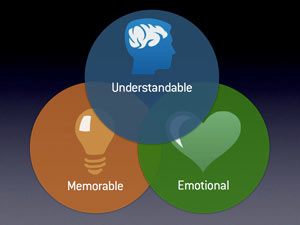3 core elements of a successful presentation
According to the author, speaker, former famous journalist Carmine Gallo, many smart leaders in the world convey their message to many people by simple expression so that 3rd graders can read and understand.
Recently, I was invited to attend the MBA graduation ceremony at Stanford business school as a speaker, as part of the "Mastery in Communication Initiative" program. This event features the "pioneers in the media" with the aim of sharing their views, recognition, and understanding and guiding new masters in the arts and sciences of persuasion, Pitching (techniques that use words to convince others, often used for special events), communication and presentation skills.
In my presentation, I shared a few specific techniques that can be used immediately (without taking a lot of hard time) to present and convince their ideas to colleagues, instructor as well as professional investors. In it, I have emphasized the three most important factors that any presentation that wants to succeed must be achieved. "Success", for a Pitching lesson that usually lasts from 5 to 10 minutes, must create an impact that is true to your original desire - making the listener act, buy or invest capital .

Successful presentations must be easy to understand, to remember and to have feelings.
Easy to understand (Understandable)
Successful presentations do not contain complex, confusing words, buzzword (words are only used in certain situations and situations) and are confusing. Although there are many ways to build a clear, understandable speech, my favorite technique is still "a Twitter-friendly title" (Simplicity in Twitter's logo and slogan: " Twitter is the bird , the bird is Twitter " is always the inspiration of many speakers." I learned this from studying the speeches of Steve Jobs and other famous inspirational speakers. In 2001, during the launch of the iPod, Jobs said "1000 songs in my iPod". This is the way he always uses to describe his products and use only one sentence. Even before Twitter existed, Jobs's product descriptions never exceeded 140 characters.
Not only famous for its creativity, this technology legend is also known for its commercial film (serving the "Think Different" campaign) "Crazy Ones" with content. as follows:
These are crazy, eccentric, rebellious, disruptive people. People who don't follow the rules. They are like a round pot with distortion. They see things differently from common sense.
They dislike the principles. They upset the status quo. You can quote them, disagree with them, honor or insult them.
But the only thing you can't do is ignore them because they change the world and push humanity forward.
And while some people consider them crazy, we find there the qualities of geniuses.
Because only people who are crazy enough to think they can change the world are the ones who really do.
Although the average grade 2 and 3 students may not understand the meaning of some words, they generally read it. And when giving the ad to my daughter who is in grade 2 reading, it is also embarrassing before two words: quotations and genius.

I also talked to Daniel Pink , the author of the bestseller "To Sell is Human" . Pink is a very knowledgeable person in public speaking skills and has many years of experience as a speechwriter in the political field before writing books. When preparing the presentation, he often wondered: "What is the biggest idea I want people to draw from this talk?"
If you are "pitching" a product, what do you want the customer or investor to understand about it? If you can describe just below 140 words, you will help listeners easily grasp the product information as well as its benefits for their life.
In addition to Steve Jobs and Daniel Pink, there are also many smart leaders who use this when conducting product launches, such as CEO Telsa Elon Musk. Musk once said he read instructions for using Soviet missiles for entertainment only, but when speaking in public, people found him speaking to the language that an average 2nd grade student could read, and In many cases, it is understandable.
For example, in the launch of Telsa's Powerwall battery in April last year, Musk explained that this product is an in-house battery capable of receiving sunlight from solar panels on rooftops and moving. turn them into reserve energy. Although they are designed for ordinary consumers, the technology behind this product is extremely complex. So in front of customers, Musk explained the product by using extremely simple language and almost no text on the slide, the whole picture.

The rest of the presentation was mostly conveyed in simple and less verbal language as possible, like former British Prime Minister Winston Churchill once said: "The short word is the best words and words. The common sense is shorter and better, their meaning will be associated with the character of the characters and that helps them attract more people. " He also used to be a former reporter, who knew that the shorter the use of words, the more people would reach.
At the same time, as technology becomes more complex, the message to customers must be as simple as possible. Don't feel stupid when you're simplifying things, because that will help you reach more customers while trying to highlight them.
Easy to remember (Memorable)
If the audience cannot remember immediately what you said during the presentation or can't recall it, it doesn't matter how great your speech is.
Similarly, there are many ways to help you convey the message in a way that is easy to remember to the listener, but my favorite technique is "The rule of three" . Neuroscientists, in general, agree that the human mind - in the short term - can only absorb about 3 to 7 issues or "working memory" - the working memory - the type of mind Remember to analyze the facts and events instantly and last for a while (This is why phone numbers have only 7 numbers. Long ago, scientists also discovered that if asking someone to remember 8 digits, they will quickly forget the whole sequence of numbers). The magic number - not too much and not too little - seems to be number 3.
So how to apply here? You can divide the presentation into 3 parts , discuss the 3 benefits of the product or show the audience the "3 action steps" they can take. Connecting content into groups of 3 best ideas is much easier to remember.

Emotional (Emotional)
There are a series of studies that show that emotional factors overwhelm rigid analysis. You need to provide data and evidence to reinforce your thesis, but expressing your emotions in the presentation is often a trigger for people to act.
Storytelling is the easiest and most effective way to make the presentation feel emotional. Once, I interviewed a very brilliant lawyer who won a very hot trial involving a pharmaceutical company and demanded $ 250 million for customers. He showed me the slide he used in an open debate. These 6 slides tell a story with images related to a murdered person. When the trial ended, he asked the jury why he changed his mind when not long ago, they were mistaken by the drug company's bar association by inviting scientists with a "mountain." "the data and statistics up testify. The jury responded that they were convinced by a simple story, rarely used but emotional and powerful.

If you want to stand out, try to tell a story that relates to what you say.
Poor communication and presentation skills can engulf your career and organizational brand. I have seen this happen many times. I have also seen so many great ideas but not recognized just because their creators cannot effectively convey their "spiritual children" to listeners. We need useful solutions to solve problems but we also need inspiring leaders who can express them in an understandable, memorable and emotional way to motivate push subordinates action.
About the author: Carmine Gallo is a communication trainer for many of the most popular brands in the world. He is also a Keynote Speaker (presenting spirit, fire) and the author of many famous titles, one of which is on the bestseller list in the world like The Presentation Secrets of Steve Jobs ( Interpretation: Steve Jobs' presentation secrets or The Innovation Secrets of Steve Jobs.
You should read it
- 10 useful tips for you when presenting with PowerPoint
- Use iPhone to control remote presentations
- How to create professional presentations in Canva
- How to save presentations in PowerPoint 2016
- If you want a nice, easy-to-understand presentation slide, you need to keep in mind the following
- Create and open presentations in PowerPoint 2016
- Rehearsal and record presentations in PowerPoint 2016
- Review presentations in PowerPoint 2016
May be interested
- How to Add an Object to a Presentation
 a presentation is something that what you want to present. presentation software is a software that creates slides for presentation. adding objects into a presentation makes the presentation better. ==== insert text via given text layout...
a presentation is something that what you want to present. presentation software is a software that creates slides for presentation. adding objects into a presentation makes the presentation better. ==== insert text via given text layout... - What's the difference between Intel Core and Intel Core X CPUs?
 intel core chips come in all shapes and forms. the series was first introduced in 2006 with the iconic intel core 2 duo, before splitting into multiple i3, i5 and i7 series in 2010.
intel core chips come in all shapes and forms. the series was first introduced in 2006 with the iconic intel core 2 duo, before splitting into multiple i3, i5 and i7 series in 2010. - Does your computer need Intel Core i3, i5 or i7?
 intel has a rather confusing way of naming microprocessors and the most frequently asked questions are: what is the difference between the i3, i5 or i7 processors? which one should i buy for a computer?
intel has a rather confusing way of naming microprocessors and the most frequently asked questions are: what is the difference between the i3, i5 or i7 processors? which one should i buy for a computer? - How to Change the Background on a Google Presentation
 google presentation is one of the applications included in the google docs office suite that lets users create slideshow presentation online without downloading any software. with google presentation, you can choose from many different...
google presentation is one of the applications included in the google docs office suite that lets users create slideshow presentation online without downloading any software. with google presentation, you can choose from many different... - Learn about E-Core and P-Core in Intel CPUs
 intel's 12th generation cpus, and then 13th generation, gave users an unexpected but interesting twist: two different types of cores in one cpu - e-core and p-core .
intel's 12th generation cpus, and then 13th generation, gave users an unexpected but interesting twist: two different types of cores in one cpu - e-core and p-core . - Intel replaced Core 2 Duo with i3, i5 and i7
 new chips from intel will be branded simply as core i3 (basic), core i5 (midrange) and core i7 (premium).
new chips from intel will be branded simply as core i3 (basic), core i5 (midrange) and core i7 (premium). - 7 things successful people never tell you
 let's see what successful people usually do but never tell us!
let's see what successful people usually do but never tell us! - How to Give a Presentation
 giving a presentation terrifies most of us, especially when talking before a crowd of people about an unfamiliar topic. never fear! there are ways to make a good presentation. the more presentations you do, the easier they will become!...
giving a presentation terrifies most of us, especially when talking before a crowd of people about an unfamiliar topic. never fear! there are ways to make a good presentation. the more presentations you do, the easier they will become!... - Elements in HTML
 the html element usually goes in pairs, including the opening tag, closing tag, and the content inside the two tags.
the html element usually goes in pairs, including the opening tag, closing tag, and the content inside the two tags. - Intel unveiled 10th generation Core i: codenamed Comet Lake-S, still 14nm but has hit the 10 core 20 thread on the popular PC line
 the most successful mainstream cpu in intel's history, core i has just been released the 10th generation codename comet lake-s.
the most successful mainstream cpu in intel's history, core i has just been released the 10th generation codename comet lake-s.










 17 tips that any graphic designer must know
17 tips that any graphic designer must know Unexpected factors can make you miss job interviews (part 2)
Unexpected factors can make you miss job interviews (part 2) 26 Dalai Lama's immortal philosophy
26 Dalai Lama's immortal philosophy To read financial statements, you must understand these basic indicators
To read financial statements, you must understand these basic indicators The secret to effective language learning from a 35-year-old man who speaks 11 languages
The secret to effective language learning from a 35-year-old man who speaks 11 languages Why should we learn to be more silent and when do we need to be silent?
Why should we learn to be more silent and when do we need to be silent?